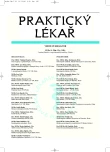Post-exercise acute rhabdomyolysis – benign sign or symptom of serious muscular disease?
Authors:
P. Kabíček 1,2; P. Chrastina 3; L. Dvořáková 3; M. Magner 3; J. Zeman 1,3
Authors‘ workplace:
Klinika dětského a dorostového lékařství 1. LF UK a VFN Praha
přednosta doc. MUDr. J. Hoza, CSc.
1; Subkatedra dorostového lékařství IPVZ Praha
ředitel MUDr. A. Malina, Ph. D., MBA.
2; Ústav dědičných poruch metabolismu, VFN Praha
přednosta prof. MUDr. M. Elleder, DrSc.
3
Published in:
Prakt. Lék. 2006; 86(7): 393-395
Category:
Case Report
Overview
Acute post-exercise rhabdomyolysis may result in the muscle-pain in combination with muscle-weakness, dark coloured urine due to myoglobinuria, and elevated serum levels of aminotransferases, creatine kinase, and myoglobin. A heterogeneous group of acquired or inherited diseases can cause these symptoms. Extreme myoglobinuria is associated with the risk of development of acute renal failure.
We describe clinical manifestation and results of biochemical and molecular analyses in two young men with acute rhabdomyolysis caused by mitochondrial disorders of beta oxidation of fatty acids.
In a 20year old patient after attack of rhabdomyolysis the VLCAD (very long-chain Acyl-Co A dehydrogenase deficiency) was diagnosed and in a 10year old boy the LCHAD (long-chain 3-OH-Acyl-CoA dehydrogenase deficiency) was revealed. Early confirmation of these mitochondrial disorders made effective therapy possible.
Key words:
rhabdomyolysis, metabolic myopathy, exercise-induced myoglobinuria, disorders of beta-oxidation of fatty acids, LCHAD, VLCAD.
Labels
General practitioner for children and adolescents General practitioner for adultsArticle was published in
General Practitioner

2006 Issue 7
Most read in this issue
- The diagnostic process in primary health care – the most frequent sources of errors and possibilities for their elimination
- Post-exercise acute rhabdomyolysis – benign sign or symptom of serious muscular disease?
- Entecavir is new drug for chronic hepatitis B treatment
- Recommended diagnostic steps for general practitioners attending patients with difficulties that could indicate multiple myeloma
